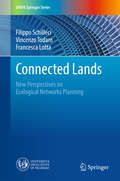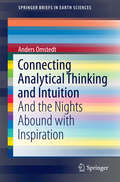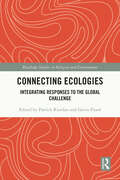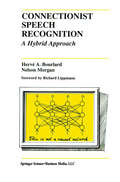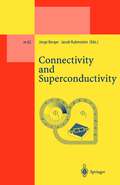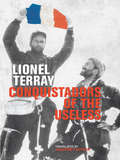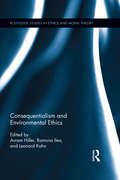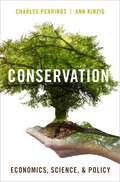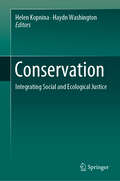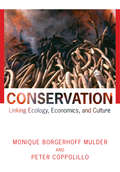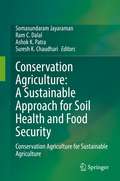- Table View
- List View
Connected Lands: New Perspectives on Ecological Networks Planning (UNIPA Springer Series)
by Filippo Schilleci Vincenzo Todaro Francesca LottaThis book explores and outlines the reference theoretical basis of ecological networks within the international debate, focusing on how protected areas should no longer be considered as the sum of different components but rather as a network. The various European, transnational and national models of ecological networks/connections are analyzed on the basis of a detailed, updated study of relevant documents. The complex picture that emerges shows a wide range of reticular-ecological models within European plans and programs, but also many non-integrated experiences. The book subsequently examines the regulation of ecological networks/connections within planning instruments, explaining the critical points and referring to different ecological network models and specific local realities. Lastly, the book addresses two Italian case studies regarding the different normative and planning frameworks, both at a national and regional level, and demonstrating not only how ecological networks/connections can be structured within plans, but also how these networks/connections represent the core element of territory development and preservation. As such, it provides an essential tool for containing habitat fragmentation, offering a new perspective that integrates theoretical approaches and methods with planning models and the lessons learned from local applications.
Connecting a Digital Europe Through Location and Place (Lecture Notes in Geoinformation and Cartography)
by Joaquín Huerta Sven Schade Carlos GranellThis book collects innovative research presented at the 17th Conference of the Association of Geographic Information Laboratories for Europe (AGILE) on Geographic Information Science, held in 2014 in Castellón, Spain. The scientific papers cover a variety of fundamental research topics as well as applied research in Geospatial Information Science, including measuring spatiotemporal phenomena, crowdsourcing and VGI, geosensor networks, indoor navigation, spatiotemporal analysis, modeling and visualization, spatiotemporal decision support, digital earth and spatial information infrastructures.The book is intended for researchers, practitioners, and students working in various fields and disciplines related to Geospatial Information Science and technology.
Connecting Analytical Thinking and Intuition: And the Nights Abound with Inspiration (SpringerBriefs in Earth Sciences)
by Anders OmstedtThis book demonstrates how analytical thinking and intuition can be systematically connected and trained. It is illustrated by figures and photographs and includes creative and stimulating exercises.We are living in a world of increasing complexity, in which perceiving reality accurately is increasingly important and difficult. Society’s need to address “global grand challenges” requires that the scientific community initiates inter-disciplinary research programmes. These are often far removed from current programmes, which are usually based on intra-disciplinary science. Improving our understanding of complex problems and communicating this understanding to a large group of people from different backgrounds represents an important educational challenge.Connecting Analytical Thinking and Intuition stimulates students and scientists to improve their skills in thinking, communicating and learning more about being humans. A guide to connecting analytical thinking and intuition is presented using the “dream group” method developed by Montague Ullman, in which a group of 6–8 people systematically and carefully helps the dreamer to appreciate dreams. The importance of good memory, which can be trained through recalling the dreams, is also discussed in relation to science and literature.
Connecting Ecologies: Integrating Responses to the Global Challenge (Routledge Studies in Religion and Environment)
by Gavin Flood Patrick RiordanConnecting Ecologies focuses on the environmental aspects of Pope Francis’ encyclical Laudato Si’ and the challenge to care for our common home. It considers how best to devise and implement the new societal models needed to tackle the ecological problems facing the world today. The book addresses the need for and complexity of an integral ecology, one that looks not only at physical and biological processes but also allows for the contributions of theology, philosophy, spirituality, and psychology, including the implications for the human and social sciences. The contributions document four categories of resonances, resources, requirements, and responses evoked by a reading of Laudato Si’ and include consideration of other faith traditions. They reflect on how care for our common home motivates people in different places, cultures, and professions to cooperate for myriad goods in common. The volume is particularly relevant for scholars working in religious studies and theology with an interest in ecology, the environment, and the Anthropocene.
Connecting Ecologies: Integrating Responses to the Global Challenge (Routledge Studies in Religion and Environment)
Connecting Ecologies focuses on the environmental aspects of Pope Francis’ encyclical Laudato Si’ and the challenge to care for our common home. It considers how best to devise and implement the new societal models needed to tackle the ecological problems facing the world today. The book addresses the need for and complexity of an integral ecology, one that looks not only at physical and biological processes but also allows for the contributions of theology, philosophy, spirituality, and psychology, including the implications for the human and social sciences. The contributions document four categories of resonances, resources, requirements, and responses evoked by a reading of Laudato Si’ and include consideration of other faith traditions. They reflect on how care for our common home motivates people in different places, cultures, and professions to cooperate for myriad goods in common. The volume is particularly relevant for scholars working in religious studies and theology with an interest in ecology, the environment, and the Anthropocene.
Connectionist Approaches in Economics and Management Sciences (Advances in Computational Management Science #6)
by Cédric Lesage Marie CottrellSince the beginning of the 1980's, a lot of news approaches of biomimetic inspiration have been defined and developed for imitating the brain behavior, for modeling non linear phenomenon, for providing new hardware architectures, for solving hard problems. They are named Neural Networks, Multilayer Perceptrons, Genetic algorithms, Cellular Automates, Self-Organizing maps, Fuzzy Logic, etc. They can be summarized by the word of Connectionism, and consist of an interdisciplinary domain between neuroscience, cognitive science and engineering. First they were applied in computer sciences, engineering, biological models, pattern recognition, motor control, learning algorithms, etc. But rapidly, it appeared that these methods could be of great interest in the fields of Economics and Management Sciences. The main difficulty was the distance between researchers, the difference in the vocabulary used by the ones and the others, their basic background. The main notions used by these new techniques were not familiar to the Social and Human Sciences researchers. What are they ? Four of them are now very briefly introduced, but the reader will find more information in the following chapters.
Connectionist Approaches to Language Learning (The Springer International Series in Engineering and Computer Science #154)
by David Touretzkyarise automatically as a result of the recursive structure of the task and the continuous nature of the SRN's state space. Elman also introduces a new graphical technique for study ing network behavior based on principal components analysis. He shows that sentences with multiple levels of embedding produce state space trajectories with an intriguing self similar structure. The development and shape of a recurrent network's state space is the subject of Pollack's paper, the most provocative in this collection. Pollack looks more closely at a connectionist network as a continuous dynamical system. He describes a new type of machine learning phenomenon: induction by phase transition. He then shows that under certain conditions, the state space created by these machines can have a fractal or chaotic structure, with a potentially infinite number of states. This is graphically illustrated using a higher-order recurrent network trained to recognize various regular languages over binary strings. Finally, Pollack suggests that it might be possible to exploit the fractal dynamics of these systems to achieve a generative capacity beyond that of finite-state machines.
Connectionist Natural Language Processing: Readings from Connection Science
by NoelSharkeyConnection science is a new information-processing paradigm which attempts to imitate the architecture and process of the brain, and brings together researchers from disciplines as diverse as computer science, physics, psychology, philosophy, linguistics, biology, engineering, neuroscience and AI. Work in Connectionist Natural Language Processing (CNLP) is now expanding rapidly, yet much of the work is still only available in journals, some of them quite obscure. To make this research more accessible this book brings together an important and comprehensive set of articles from the journal CONNECTION SCIENCE which represent the state of the art in Connectionist natural language processing; from speech recognition to discourse comprehension. While it is quintessentially Connectionist, it also deals with hybrid systems, and will be of interest to both theoreticians as well as computer modellers. Range of topics covered: Connectionism and Cognitive Linguistics Motion, Chomsky's Government-binding Theory Syntactic Transformations on Distributed Representations Syntactic Neural Networks A Hybrid Symbolic/Connectionist Model for Understanding of Nouns Connectionism and Determinism in a Syntactic Parser Context Free Grammar Recognition Script Recognition with Hierarchical Feature Maps Attention Mechanisms in Language Script-Based Story Processing A Connectionist Account of Similarity in Vowel Harmony Learning Distributed Representations Connectionist Language Users Representation and Recognition of Temporal Patterns A Hybrid Model of Script Generation Networks that Learn about Phonological Features Pronunciation in Text-to-Speech Systems
Connectionist Speech Recognition: A Hybrid Approach (The Springer International Series in Engineering and Computer Science #247)
by Hervé A. Bourlard Nelson MorganConnectionist Speech Recognition: A Hybrid Approach describes the theory and implementation of a method to incorporate neural network approaches into state of the art continuous speech recognition systems based on hidden Markov models (HMMs) to improve their performance. In this framework, neural networks (and in particular, multilayer perceptrons or MLPs) have been restricted to well-defined subtasks of the whole system, i.e. HMM emission probability estimation and feature extraction. The book describes a successful five-year international collaboration between the authors. The lessons learned form a case study that demonstrates how hybrid systems can be developed to combine neural networks with more traditional statistical approaches. The book illustrates both the advantages and limitations of neural networks in the framework of a statistical systems. Using standard databases and comparison with some conventional approaches, it is shown that MLP probability estimation can improve recognition performance. Other approaches are discussed, though there is no such unequivocal experimental result for these methods. Connectionist Speech Recognition is of use to anyone intending to use neural networks for speech recognition or within the framework provided by an existing successful statistical approach. This includes research and development groups working in the field of speech recognition, both with standard and neural network approaches, as well as other pattern recognition and/or neural network researchers. The book is also suitable as a text for advanced courses on neural networks or speech processing.
Connections (New Key Geography Ser. (PDF))
by David Waugh Tony Bushell Grant WestobySupporting resources in the New Key Geography series, this Teacher's Resource Guide and accompanying CD-ROM includes teacher notes, planning resources, assessment activities and suggestions for cross-curricular links.
Connectivity and Superconductivity (Lecture Notes in Physics Monographs #62)
by Jorge Berger Jacob RubinsteinThe motto of connectivity and superconductivity is that the solutions of the Ginzburg–Landau equations are qualitatively in?uenced by the topology of the boundaries. Special attention is given to the “zero set”,the set of the positions (usually known as “quantum vortices”) where the order parameter vanishes. The paradigm of connectivity and superconductivity is the Little– Parks e?ect,discussed in most textbooks on superconductivity. This volume is intended to serve as a reference book for graduate students and researchers in physics or mathematics interested in superconductivity, or in the Schr¨ odinger equation as a limiting case of the Ginzburg–Landau equations. The e?ects considered here usually become important in the regime where the coherence length is of the order of the dimensions of the sample. While in the Little–Parks days a lot of ingenuity was required to achieve this regime, present microelectronic techniques have transformed it into a routine. Mo- over,measurement and visualization techniques are developing at a pace which makes it reasonable to expect veri?cation of distributions,and not only of global properties. Activity in the ?eld has grown and diversi?ed substantially in recent years. We have therefore invited experts ranging from experimental and theoretical physicists to pure and applied mathematicians to contribute articles for this book. While the skeleton of the book deals with superconductivity,micron- works and generalizations of the Little–Parks situation,there are also articles which deal with applications of the Ginzburg–Landau formalism to several fundamental topics,such as quantum coherence,cosmology,and questions in materials science.
Connectivity Conservation Management: A Global Guide
by Graeme L. Worboys Wendy L. Francis Michael LockwoodIn an era of climate change, deforestation and massive habitat loss, we can no longer rely on parks and protected areas as isolated 'islands of wilderness' to conserve and protect vital biodiversity. Increasing connections are being considered and made between protected areas and 'connectivity' thinking has started to expand to the regional and even the continental scale to match the challenges of conserving biodiversity in the face of global environmental change. This groundbreaking book is the first guide to connectivity conservation management at local, regional and continental scales. Written by leading conservation and protected area management specialists under the auspices of the World Commission on Protected Areas of IUCN, the International Union for the Conservation of Nature, this guide brings together a decade and a half of practice and covers all aspects of connectivity planning and management The book establishes a context for managing connectivity conservation and identifies large scale naturally interconnected areas as critical strategic and adaptive responses to climate change. The second section presents 25 rich and varied case studies from six of the eight biogeographic realms of Earth, including the Cape Floristic Region of Africa, the Maloti-Drakensberg Mountains, the Australian Alps to Atherton Corridor, and the Sacred Himalayan Landscape connectivity area (featuring Mount Everest.) The remarkable 3200 kilometre long Yellowstone to Yukon corridor of Canada and the United States of America is described in detail. The third section introduces a model for managing connectivity areas, shaped by input from IUCN workshops held in 2006 and 2008 and additional research. The final chapter identifies broad guidelines that need to be considered in undertaking connectivity conservation management prior to reinforcing the importance and urgency of this work. This handbook is a must have for all professionals in protected area management, conservation, land management and resource management from the field through senior management and policy. It is also an ideal reference for students and academics in geography, protected area management and from across the environmental and natural sciences, social sciences and landuse planning. Published with Wilburforce Foundation, WWF, ICIMOD, IUCN, WCPA, Australian Alps and The Nature Conservancy.
Connectivity Conservation Management: A Global Guide
by Graeme L. Worboys Wendy L. Francis Michael LockwoodIn an era of climate change, deforestation and massive habitat loss, we can no longer rely on parks and protected areas as isolated 'islands of wilderness' to conserve and protect vital biodiversity. Increasing connections are being considered and made between protected areas and 'connectivity' thinking has started to expand to the regional and even the continental scale to match the challenges of conserving biodiversity in the face of global environmental change. This groundbreaking book is the first guide to connectivity conservation management at local, regional and continental scales. Written by leading conservation and protected area management specialists under the auspices of the World Commission on Protected Areas of IUCN, the International Union for the Conservation of Nature, this guide brings together a decade and a half of practice and covers all aspects of connectivity planning and management The book establishes a context for managing connectivity conservation and identifies large scale naturally interconnected areas as critical strategic and adaptive responses to climate change. The second section presents 25 rich and varied case studies from six of the eight biogeographic realms of Earth, including the Cape Floristic Region of Africa, the Maloti-Drakensberg Mountains, the Australian Alps to Atherton Corridor, and the Sacred Himalayan Landscape connectivity area (featuring Mount Everest.) The remarkable 3200 kilometre long Yellowstone to Yukon corridor of Canada and the United States of America is described in detail. The third section introduces a model for managing connectivity areas, shaped by input from IUCN workshops held in 2006 and 2008 and additional research. The final chapter identifies broad guidelines that need to be considered in undertaking connectivity conservation management prior to reinforcing the importance and urgency of this work. This handbook is a must have for all professionals in protected area management, conservation, land management and resource management from the field through senior management and policy. It is also an ideal reference for students and academics in geography, protected area management and from across the environmental and natural sciences, social sciences and landuse planning. Published with Wilburforce Foundation, WWF, ICIMOD, IUCN, WCPA, Australian Alps and The Nature Conservancy.
Conquistadors of the Useless: From the Alps to Annapurna
by Lionel Terray'I have given my whole life to the mountains. Born at the foot of the Alps, I have been a ski champion, a professional guide, an amateur of the greatest climbs in the Alps and a member of eight expeditions to the Andes and the Himalayas. If the word has any meaning at all, I am a mountaineer.' So Terray begins Conquistadors of the Useless- not with arrogance, but with typical commitment. One of the most colourful characters of the mountaineering world, his writing is true to his uncompromising and jubilant love for the mountains. Terray was one of the greatest alpinists of his time, and his autobiography is one of the finest and most important mountaineering books ever written. Climbing with legends Gaston Rébuffat, Maurice Herzog and Louis Lachenal, Terray made first ascents in the Alps, Alaska, the Andes, and the Himalaya. He was at the centre of global mountaineering at a time when Europe was emerging from the shadow of World War II, and he came out a hero. Conquistadors tells of his war-time escapades, of life as an Alpine mountain guide, and of his climbs - including the second ascent of the Eiger North Face and his involvement in the first ever ascent of an 8,000-metre peak, Annapurna. His tales capture the energy of French post-war optimism, a time when France needed to re-assert herself and when climbing triumphs were more valued than at any other time in history. Terray's death, in the Vercors, robbed mountaineering of one of its most passionate and far-sighted figures. His energy, so obvious in Conquistadors of the Useless, will inspire for generations to come. A mountaineering classic.
Conscious Business in Germany: Assessing the Current Situation and Creating an Outlook for a New Paradigm (CSR, Sustainability, Ethics & Governance)
by Nicolas Josef Stahlhofer Christian Schmidkonz Patricia KraftThis book presents conscious business as a constantly expanding and powerful approach to reinvent and shape organizations in a human and beneficial manner. In particular it examines the core characteristics, main drivers and challenges of conscious businesses in Germany. The book offers a structured overview of the current situation of the concept and outlines important issues that need to be considered in order to make independent decisions. Four case studies of successful conscious companies – differing in terms of their size, industry, legal form and international orientation – reveal concrete best practices and provide evidence for the approach’s ability to deliver business paradigms that are simultaneously purposeful and profitable.
Conscious Collaboration: Re-Thinking The Way We Work Together, For Good
by Ben EmmensWhen collaboration works, the results can be breath-taking! But it doesn’t always deliver on its potential. Collaboration has been defined as "an unnatural act practiced by non-consenting adults". And often that’s exactly what it is! Some collaboration can be painfully difficult with the result that problems are either ignored or smoothed over until the collaboration falters or disintegrates, or self-interest and personal agendas take over and conflict quickly arises.Collaboration and partnerships work well in the aid sector because they have to – no one body has the resources to solve massive problems on their own. Business often sees the advantages of collaboratively sharing costs without fully recognizing the shift in mindset that is required to take managers with a “winner takes all” worldview and get them performing effectively in a win-win world.Part of the solution lies in bringing consciousness to the workplace and developing it as a core competence. A conscious approach to business relationships, planning, and delivery can enable individuals and organizations to truly think about what they are doing, make changes where needed, and become more effective. It is a particularly effective way of managing the multiple and occasionally conflicting stakeholder objectives inherent in any collaborative project. The author draws on his experience in the aid sector and with non-profit organizations to describe the building blocks that underpin successful collaboration, and inspires us to re-think the way we work together, for good.
Consequentialism and Environmental Ethics (Routledge Studies in Ethics and Moral Theory)
by Avram Hiller Ramona Ilea Leonard KahnThis volume works to connect issues in environmental ethics with the best work in contemporary normative theory. Environmental issues challenge contemporary ethical theorists to account for topics that traditional ethical theories do not address to any significant extent. This book articulates and evaluates consequentialist responses to that challenge. Contributors provide a thorough and well-rounded analysis of the benefits and limitations of the consequentialist perspective in addressing environmental issues. In particular, the contributors use consequentialist theory to address central questions in environmental ethics, such as questions about what kinds of things have value; about decision-making in light of the long-term, intergenerational nature of environmental issues; and about the role that a state’s being natural should play in ethical deliberation.
Consequentialism and Environmental Ethics (Routledge Studies in Ethics and Moral Theory)
by Avram Hiller Ramona Ilea Leonard KahnThis volume works to connect issues in environmental ethics with the best work in contemporary normative theory. Environmental issues challenge contemporary ethical theorists to account for topics that traditional ethical theories do not address to any significant extent. This book articulates and evaluates consequentialist responses to that challenge. Contributors provide a thorough and well-rounded analysis of the benefits and limitations of the consequentialist perspective in addressing environmental issues. In particular, the contributors use consequentialist theory to address central questions in environmental ethics, such as questions about what kinds of things have value; about decision-making in light of the long-term, intergenerational nature of environmental issues; and about the role that a state’s being natural should play in ethical deliberation.
Conservation: Economics, Science, and Policy
by Ann Kinzig Charles PerringsA unified theory of conservation that addresses the broad problem of conservation, the principles that inform conservation choices, and the application of those principles to the management of the natural world. The conservation of natural resources, like that of any other asset, involves trade-offs. Yet, in a world faced with the harsh realities of climate change, crafting the right environmental policies is an increasingly urgent task. In Conservation, Charles Perrings and Ann Kinzig bring together new research in economics and biodiversity to investigate conservation decisions and the theory behind them. Perrings and Kinzig apply the concept of conservation broadly to examine how the principles of conservation apply to the management of the natural world. They demonstrate that the same basic principles serve as the foundation of all rational conservation decisions, from managing financial assets to safeguarding at-risk ecosystems. Whether someone is deciding to hold or dispose of a stock or whether to exploit or preserve a natural resource, they are better off choosing to conserve a resource when its value to them, if conserved, is greater than its value when converted. The book also considers the context of such conservation decisions. Just as national tax rules influence choices about financial investments, environmental regulations within countries, and environmental agreements between countries, impact the decisions regarding natural resources. Building on their basic theory of conservation, Perrings and Kinzig address key issues in the field of environmental economics, including the valuation of ecosystem services and environmental assets; the limits on the substitutability of produced and natural capital; and the challenges posed by the often weak markets for ecosystem services oriented toward the public good. They also address the problem of scale: while decisions might be easier to make at the local level, many conservation policies need to apply at either the national or international level to succeed. Written by experts from both social and hard sciences, this book presents a unified theory of conservation and provides a model for a more effective way to approach the vitally important issue.
Conservation: Integrating Social and Ecological Justice
by Helen Kopnina Haydn WashingtonThis book provides keys to decrypt current political debates on the environment in light of the theories that support them, and provides tools to better understand and manage environmental conflicts and promote environmentally friendly behaviour. As we work towards global sustainability at a time when efforts to conserve biodiversity and combat climate change correspond with land grabs by large corporations, food insecurity, and human displacement. While we seek to reconcile more-than-human relations and responsibilities in the Anthropocene, we also struggle to accommodate social justice and the increasingly global desire for economic development. These and other challenges fundamentally alter the way social scientists relate to communities and the environment. This book takes as its point of departure today’s pressing environmental challenges, particularly the loss of biodiversity, and the role of communities in protected areas conservation. In its chapters, the authors discuss areas of tension between local livelihoods and international conservation efforts, between local communities and wildlife, and finally between traditional ways of living and ‘modernity’. The central premise of this book is while these tensions cannot be easily resolved they can be better understood by considering both social and ecological effects, in equal measure. While environmental problems cannot be seen as purely ecological because they always involve people, who bring to the environmental table their different assumptions about nature and culture, so are social problems connected to environmental constraints. While nonhumans cannot verbally bring anything to this negotiating table, aside from vast material benefits that society relies on, the distinct perspective of this book is that there is a need to consider the role of nonhumans as equally important stakeholders – albeit without a voice. This book develops an argument that human-environmental relationships are set within ecological reality and ecological ethics and rather than being mutually constitutive processes, humans have obligate dependence on nature, not vice versa. This would enable an ethical position encompassing the needs of other species and giving simultaneous (without one being subordinated to another) consideration to justice for humans and non-humans alike. The book is accessible to both social scientists and conservation specialists, and intends to contribute to strengthening interdisciplinary collaborations in the field of conservation.
Conservation: Linking Ecology, Economics, and Culture (PDF)
by Monique Borgerhoff Mulder Peter CoppolilloNearly 90 percent of the earth's land surface is directly affected by human infrastructure and activities, yet less than 5 percent is legally "protected" for biodiversity conservation--and even most large protected areas have people living inside their boundaries. In all but a small fraction of the earth's land area, then, conservation and people must coexist. Conservation is a resource for all those who aim to reconcile biodiversity with human livelihoods. It traces the historical roots of modern conservation thought and practice, and explores current perspectives from evolutionary and community ecology, conservation biology, anthropology, political ecology, economics, and policy. The authors examine a suite of conservation strategies and perspectives from around the world, highlighting the most innovative and promising avenues for future efforts. Exploring, highlighting, and bridging gaps between the social and natural sciences as applied in the practice of conservation, this book provides a broad, practically oriented view. It is essential reading for anyone involved in the conservation process--from academic conservation biology to the management of protected areas, rural livelihood development to poverty alleviation, and from community-based natural resource management to national and global policymaking.
Conservation: Economics, Science, and Policy
by Charles Perrings Ann KinzigA unified theory of conservation that addresses the broad problem of conservation, the principles that inform conservation choices, and the application of those principles to the management of the natural world. The conservation of natural resources, like that of any other asset, involves trade-offs. Yet, in a world faced with the harsh realities of climate change, crafting the right environmental policies is an increasingly urgent task. In Conservation, Charles Perrings and Ann Kinzig bring together new research in economics and biodiversity to investigate conservation decisions and the theory behind them. Perrings and Kinzig apply the concept of conservation broadly to examine how the principles of conservation apply to the management of the natural world. They demonstrate that the same basic principles serve as the foundation of all rational conservation decisions, from managing financial assets to safeguarding at-risk ecosystems. Whether someone is deciding to hold or dispose of a stock or whether to exploit or preserve a natural resource, they are better off choosing to conserve a resource when its value to them, if conserved, is greater than its value when converted. The book also considers the context of such conservation decisions. Just as national tax rules influence choices about financial investments, environmental regulations within countries, and environmental agreements between countries, impact the decisions regarding natural resources. Building on their basic theory of conservation, Perrings and Kinzig address key issues in the field of environmental economics, including the valuation of ecosystem services and environmental assets; the limits on the substitutability of produced and natural capital; and the challenges posed by the often weak markets for ecosystem services oriented toward the public good. They also address the problem of scale: while decisions might be easier to make at the local level, many conservation policies need to apply at either the national or international level to succeed. Written by experts from both social and hard sciences, this book presents a unified theory of conservation and provides a model for a more effective way to approach the vitally important issue.
Conservation Agriculture: An Approach to Combat Climate Change in Indian Himalaya
by Jaideep Kumar Bisht Vijay Singh Meena Pankaj Kumar Mishra Arunava PattanayakThis book showcases a compilation of case studies presented by scientists, teachers and academics and covers contemporary technologies for combating climate change, including sustainable agricultural management practices and conservation agriculture. It highlights the situations that future generations in the Indian Himalayas will face, and addresses the major challenges for tomorrow’s generations in their efforts to ensure sufficient food production for the global population. It also sheds light on the factors that are routinely ignored in connection with agricultural management practices for sustainable food production and risk assessment. Lastly, it illustrates the need to develop a comprehensive master plan for strategic planning, including conservation agriculture practices that address poverty and food security in the wake of climate change impacts.
Conservation Agriculture
by Muhammad Farooq Kadambot H. M. SiddiqueConservation agriculture—consisting of four components including permanent soil cover, minimum soil disturbance, diversified crop rotations and integrated weed management—is considered the principal pathway to sustainable agriculture and the conservation of natural resources and the environment. Leading researchers in the field describe the basic principles of conservation agriculture, and synthesize recent advances and developments in conservation agriculture research. This book is a ready reference on conservation agriculture and reinforces the understanding for its utilization to develop environmentally sustainable and profitable food production systems. The book describes various elements of conservation agriculture; highlights the associated breeding and modeling efforts; analyses the experiences and challenges in conservation agriculture in different regions of the world; and proposes some pragmatic options and new areas of research in this very important area of agriculture.
Conservation Agriculture: Conservation Agriculture for Sustainable Agriculture
by Somasundaram Jayaraman Ram C. Dalal Ashok K. Patra Suresh K. ChaudhariFeeding the increasing global population, which is projected to reach ~10 billion by 2050, there has been increasing demands for more improved/sustainable agricultural management practices that can be followed by farmers to improve productivity without jeopardizing the environment and ecosystem. Indeed, about 95% of our food directly or indirectly comes from soil. It is a precious resource, and sustainable soil management is a critical socio–economic and environmental issue. Maintaining the environmental sustainability while the world is facing resource degradation, increasing climate change and population explosion is the current challenge of every food production sectors. Thus, there is an urgent need to evolve a holistic approach such as conservation agriculture to sustain higher crop productivity in the country without deteriorating soil health. Conservation Agriculture (CA), is a sustainable approach to manage agro–ecosystems in order to improve productivity, increase farm profitabilty and food security and also enhance the resource base and environment. Worldwide, it has been reported various benefits and prospects in adopting CA technologies in different agro-climatic conditions. Yet, CA in arid and semi-arid regions of India and parts of south Asia raises uncertainities due to its extreme climates, large scale residue burning, soil erosion and other constraints such as low water holding capacity, high potential evapotranspiration, etc . Thus, the proposed book has 30 chapters addressing all issues relevant to conservation agriculture/no-till farming system. The book also gives further strengthening existing knowledge in relation to soil physical, chemical and biological processes and health within close proximity of CA as well as machinery requirements. Moreover, the information on carbon (C) sequestration, C credits, greenhouse gas (GHG) emission, mitigation of climate change effects and socio-economic view on CA under diverse ecologies namely rainfed, irrigated and hill eco-region is also deliberated. For large scale adoption of CA practices in South Asian region especially in India and other countries need dissemination of best-bet CA technologies for dominant soil types/cropping systems through participatory mode, strong linkages and institutional mechanism and public-private-policy support.We hope this book gives a comprehensive and clear picture about conservation agriculture/no-till farming and its associated problem, challenges, prospects and benefits. This book shall be highly useful reference material to researchers, scientists, students, farmers and land managers for efficient and sustainable management of natural resources.
